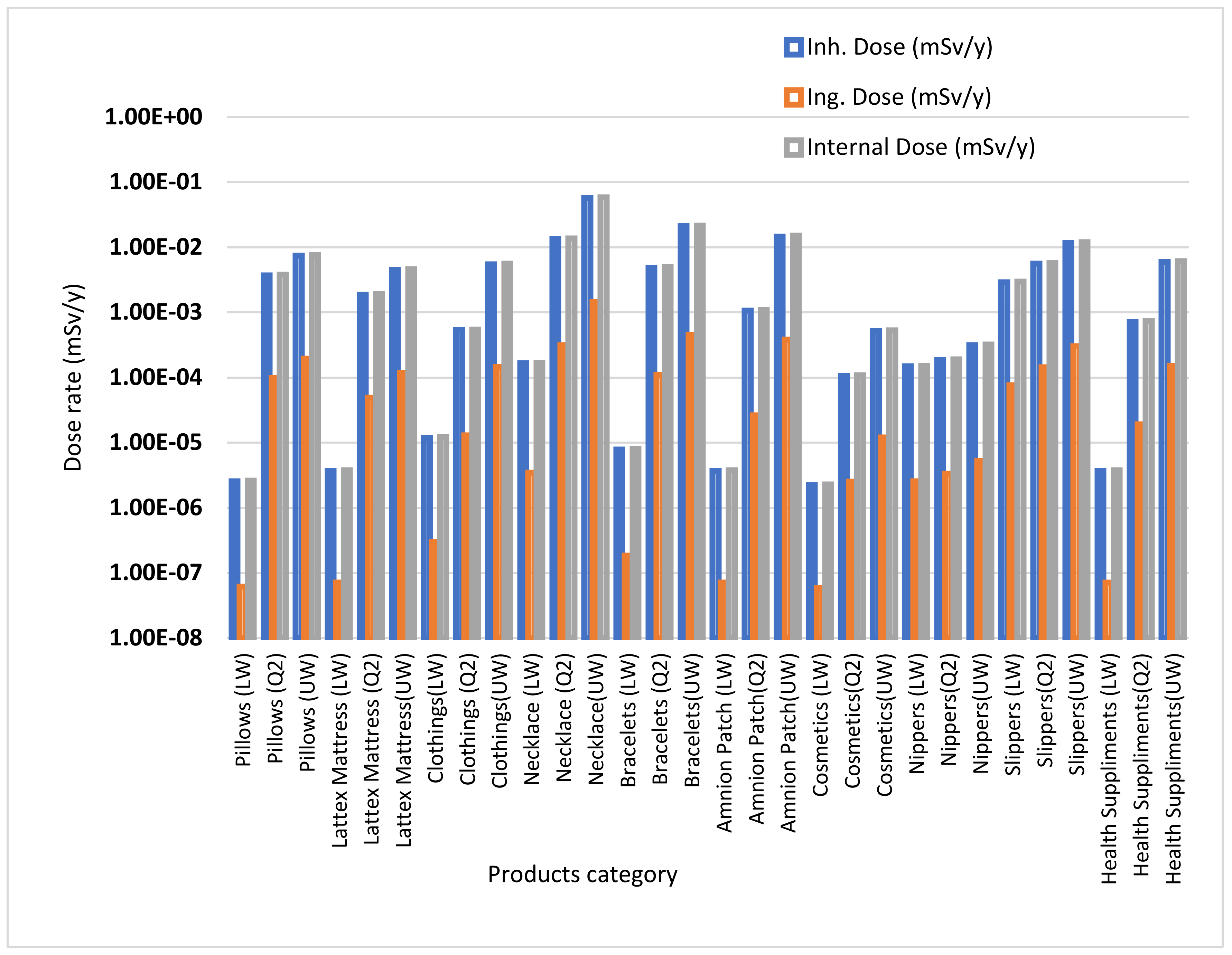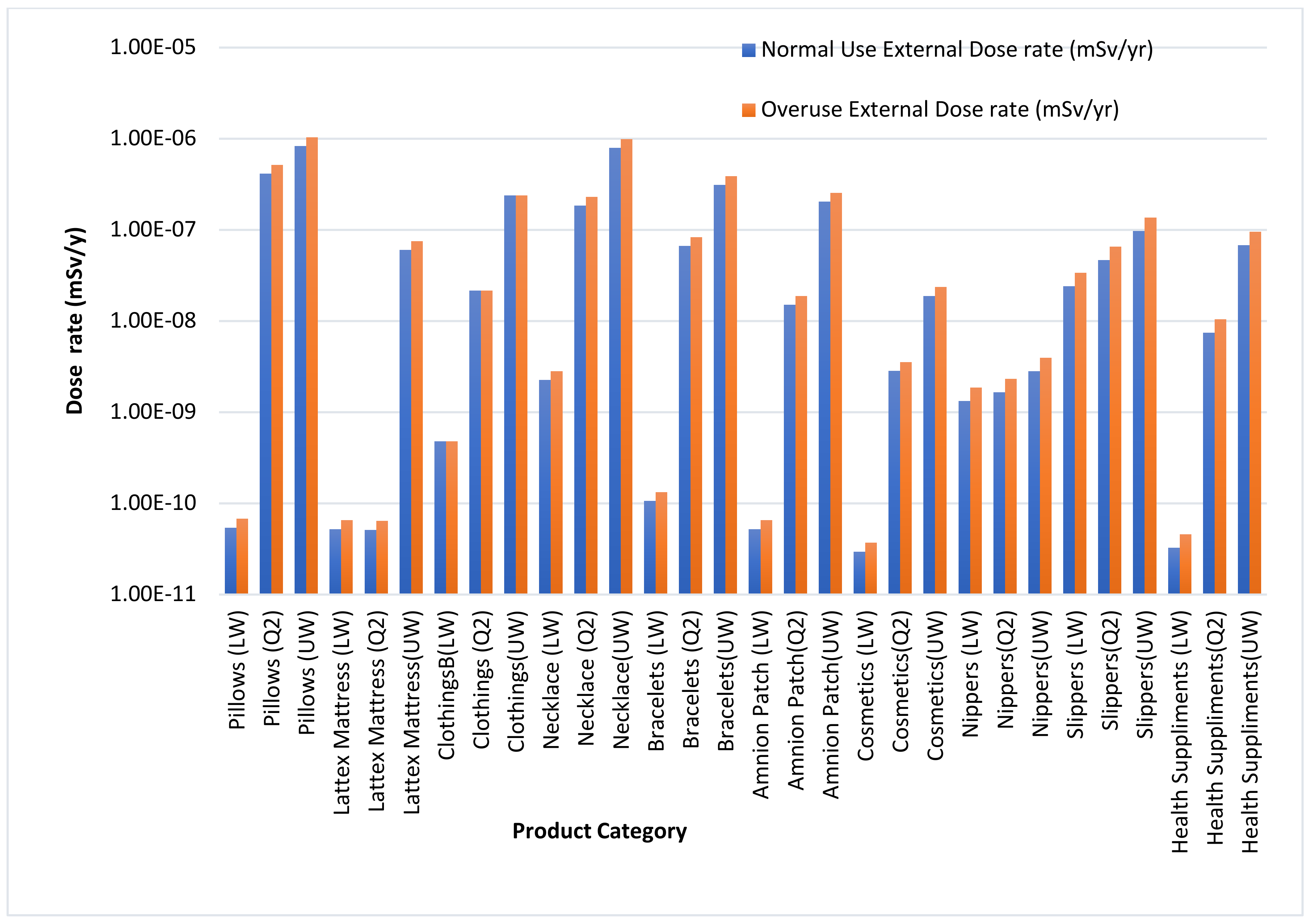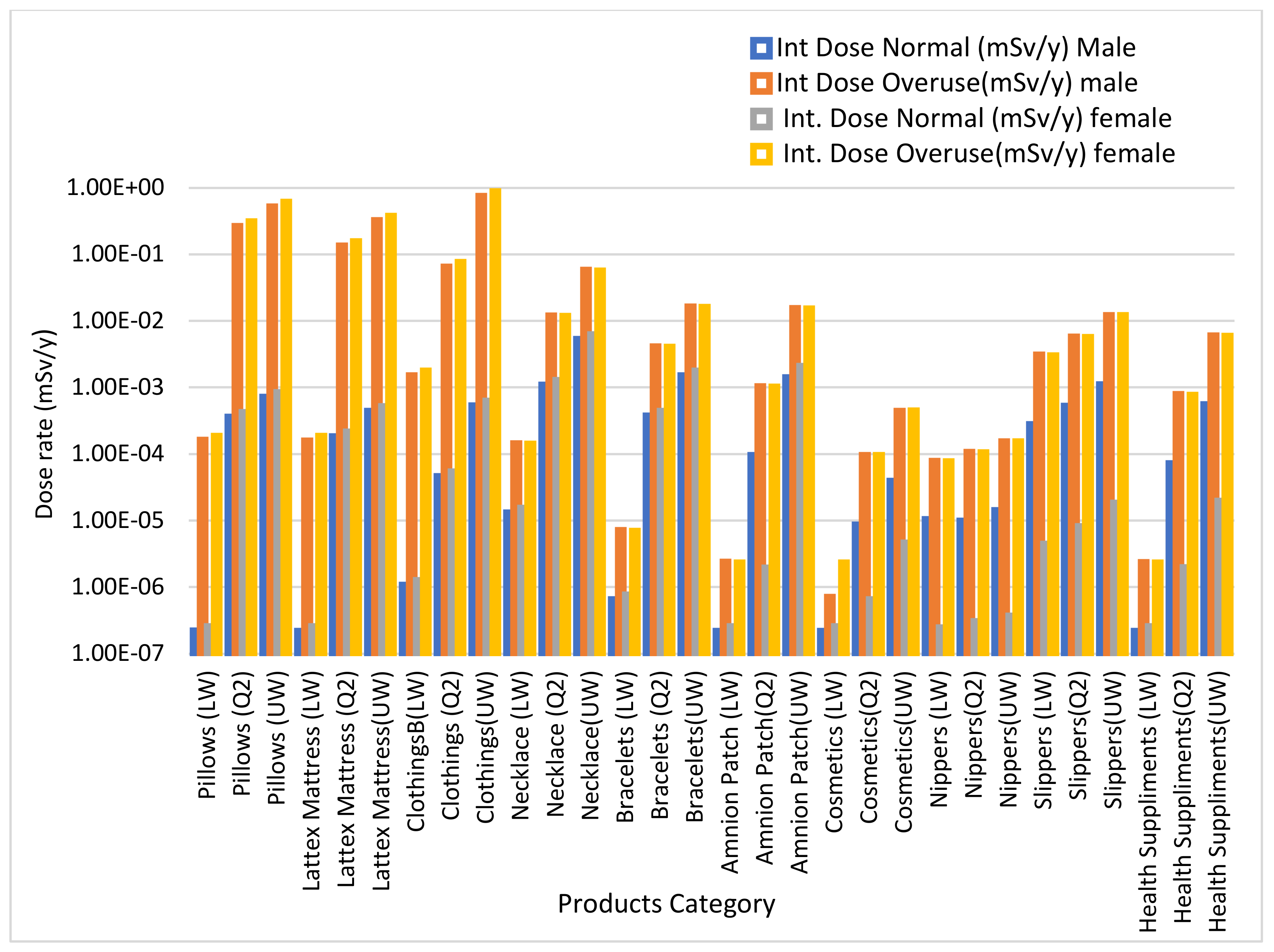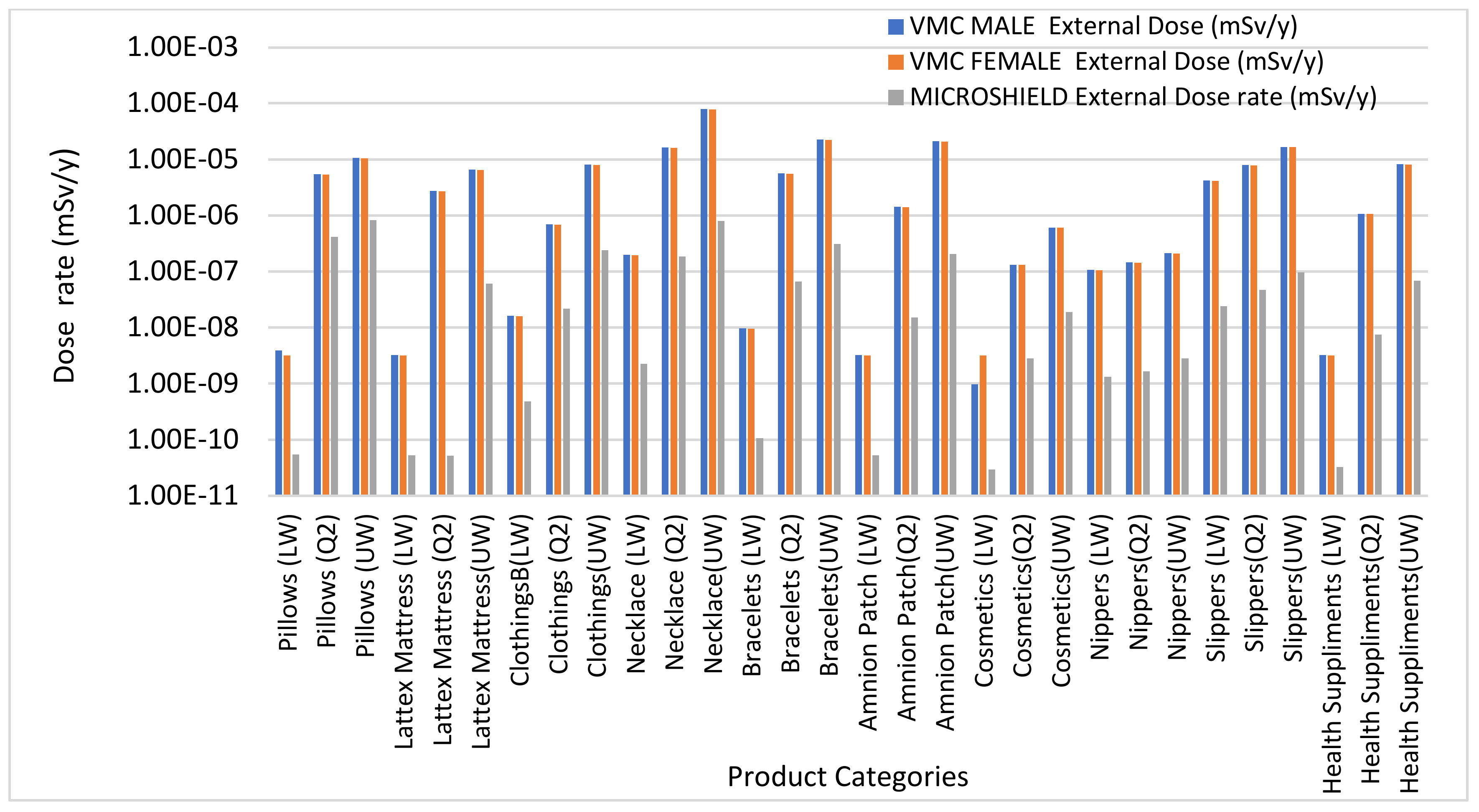Radiological Dose Assessment to Members of the Public Using Consumer Products Containing Naturally Occurring Radioactive Materials in Korea
Abstract
:1. Introduction
2. Materials and Methods
2.1. Hypothetical Usage Scenariosd
2.2. Dose Assessment Methodology
2.2.1. Effective Dose Coefficients
2.2.2. External Dose Assessment
2.2.3. Internal Dose Assessment
2.2.4. Total Effective Dose
2.3. Microshield Code
2.4. Integrated Module for Bioassay Analysis (IMBA) Code
2.5. Visual Monte Carlo (VMC) Code
3. Results
3.1. Age-Dependent Dose Calculation
3.2. Internal Dose Calculation Using IMBA Code
3.3. External Dose Using Microshield Code
3.4. Visual Monte Carlo (VMC) Code
3.5. Code Comparison for External and Internal Dose Calculations
4. Discussion
5. Conclusions
Supplementary Materials
Author Contributions
Funding
Institutional Review Board Statement
Informed Consent Statement
Data Availability Statement
Acknowledgments
Conflicts of Interest
References
- Furuta, E.; Minowa, H.; Nakahara, H.; Iwaoka, K.; Yonehara, H. Classification of ores used for the radiation source in NORM as consumer products by PGAA. Proc. Radiochim. Acta 2011, 1, 219–225. [Google Scholar] [CrossRef]
- United States Nuclear Regulatory Commission. Systematic Radiological Assessment of Exemptions for Source and Byproduct Materials; NUREG-1717; USNRC: Washington, DC, USA, 2001. [Google Scholar]
- Wanook, J.; Eun-Hee, K. Radiation exposure of NORM workers in Korea: Current status and suggestions. In Proceedings of the Transactions of the Korean Nuclear Society Autumn Meeting, Gyeongju, Korea, 29–30 October 2015. [Google Scholar]
- Yoonhee, J.; Jong-Myoung, L.; Young-Yong, J.; Kun, H.C.; Mun, J.K. The transport characteristics of 238U, 232Th, 226Ra, and 40K in the production cycle of phosphate rock. J. Radiat. Prot. Res. 2017, 42, 33–41. [Google Scholar]
- Jung, H.J.; Seung, W.J.; Jin, H.P.; Ji, Y.S.; Woo, J.K.; Kwang, P.K. Assessment of radiation dose to workers resulting from external exposure to potassium in NORM Industries in Korea. J. Korean Phys. Soc. 2018, 72, 1387–1392. [Google Scholar] [CrossRef]
- International Atomic Energy Agency. Radiation Safety for Consumer Products; IAEA Safety Standard Series No: SSG-36; International Atomic Energy Agency: Vienna, Austria, 2016. [Google Scholar]
- Do, H.Y.; Hyun, J.P.; Chul, H.M. Evaluation of annual effective dose due to external irradiation induced by using NORM-added consumer products. J. Appl. Radiat. Isot. 2019, 154, 108860. [Google Scholar]
- United States Nuclear Regulatory Commission. Radioactivity in Consumer Products; NUREG/CP-0001; USNRC: Washington, DC, USA, 1978. [Google Scholar]
- Furuta, E. NORM as consumer products: Issue of their being. Radiat. Prot. Dosim. 2011, 146, 178–182. [Google Scholar] [CrossRef] [PubMed]
- International Commission on Radiological Protection. Occupational Intakes of Radionuclides: Part 1; ICRP Publication 130; ICRP: Ottawa, ON, Canada, 2015; Volume 44. [Google Scholar]
- Shaw, J.; Dunderdale, J.; Paynter, R.A. Guidelines for the Regulatory Control of Consumer Product Containing Radioactive Materials in the European Union; European Commission Radiation Protection: Brussels, Belgium, 2007; Volume 1, pp. 14–16. [Google Scholar]
- Lee, H.C.; Yoo, D.H.; Testa, M.; Shin, W.G.; Choi, H.J.; Ha, W.H.; Yoo, J.; Yoon, S.; Chul, H.M. Effective dose evaluation of NORM-added consumer products using Monte Carlo simulations and the ICRP Computational Human Phantoms. J. Appl. Radiat. Isot. 2016, 110, 230–235. [Google Scholar] [CrossRef]
- International Commission on Radiation Protection. Dose Coefficients for Intakes of Radionuclides by Workers; ICRP Publication 68; Pergamon Press: Oxford, UK, 1994. [Google Scholar]
- International Commission on Radiation Protection. Human Respiratory Tract Model for Radiological Protection; ICRP Publication 66; Pergamon Press: Oxford, UK, 1994. [Google Scholar]
- International Commission on Radiological Protection (ICRP). Compendium of Dose Coefficients Based on ICRP Publication 60; ICRP Publication 119; ICRP: Ottawa, ON, Canada, 2012. [Google Scholar]
- International Commission on Radiological Protection (ICRP). Dose Coefficients for External Exposures to Environmental Sources; ICRP Publication 144; ICRP: Ottawa, ON, Canada, 2020. [Google Scholar]
- Eckerman, K.F.; Leggett, R.W. DCFPAK: Dose coefficient data file package for Sandia National Laboratory. In Oak Ridge National Laboratory Report ORNL/TM-13347; Oak Ridge National Laboratory: Oak Ridge, TN, USA, 1996. [Google Scholar]
- Grove Software, Inc. MicroShield Pro User’s Manual Version 12. 2020. Available online: http://www.radiationsoftware.co (accessed on 6 April 2021).
- Birchall, A.; Marsh, J.W.; Davis, K.; Bailey, M.R.; Jarvis, N.S.; Peach, A.D.; Puncher, M.; Dorrian, M.D.; James, A.C. IMBA Professional Plus Manual to Estimate Intakes and Doses; IMBA Professional Plus: London, UK, 2005. [Google Scholar]
- Hunt, J.G.; Silva, F.C.; Santos, D.S.; Malatova, I.; Dantas, B.M.; Azeredo, A. Visual Monte Carlo and Its Application in Internal and External Dosimetry. In Proceedings of the Monte Carlo 2000 Conference, Lisbon, Portugal, 23–26 October 2000. [Google Scholar]
- Marsh, J.W.; Birchall, A.; Jarvis, N.S. Validation of IMBA and IMBA expert. In Proceedings of the Harmonization of Radiation Protection in Europe: European IRPA Congress 2002, Florence, Italy, 8–11 October 2002. [Google Scholar]








| Product Categories | EU Classifications | Usage Location | Average Usage Time (per Day) | Assumed Condition for Overuse | Exposure Pathways | |
|---|---|---|---|---|---|---|
| Normal Use [12] | Overuse Day | |||||
| Pillows | Existing Products | Head, neck | 7 h 50 min | 9 h 50 min | Sickness/oversleeping | Inhalation |
| Latex Mattress | Existing Products | Whole body | 7 h 50 min | 9 h 50 min | Sickness/oversleeping | Inhalation |
| Clothing | Existing Products | Depending on usage | 24 h | 1 day 2 h | overuse | Inhalation |
| Necklace | Existing Products | Neck | 8 h 7 min | 10 h 7 min | overuse | Inhalation |
| Bracelets | Existing Products | Hand | 8 h 7 min | 10 h 7 min | overuse | Inhalation |
| Amnion Patch | Existing Products | Body for wound covering | 8 h 7 min | 10 h 7 min | overuse | Inhalation and ingestion |
| Cosmetics | Existing Products | Face and body | 8 h 7min | 10 h 7 min | Accidental Ingestion | Ingestion |
| Dippers | Existing Products | Depending on usage | 20 min | 2 h 20 min | overuse | Inhalation |
| Slippers | Existing Products | Foot wares | 5 h 1 min | 7 h 1 min | overuse | Inhalation |
| Health Supplements | Existing Products | Waist, abdomen, etc. | 5 h 1 min | 7 h 1 min | overuse | External and inhalation |
| Nuclide | T1/2 | Effective Dose Coefficient for Inhalation (Sv/Bq) [15]. | ||||
|---|---|---|---|---|---|---|
| Type | fi | 1 Year Old | 10-Year-Old | Adult | ||
| 238U | 4.468 × 109 | F | 0.02 | 1.3 × 10−6 | 7.3 × 10−4 | 5.0 × 10−7 |
| M | 0.02 | 9.4 × 10−6 | 4.0 × 10−4 | 2.9 × 10−6 | ||
| S | 0.002 | 2.5 × 10−6 | 1.0 × 10−4 | 8.0 × 10−6 | ||
| 232Th | 1.405 × 101 | F | 0.0005 | 2.2 × 10−6 | 1.3 × 10−4 | 1.1 × 10−4 |
| M | 0.0005 | 8.1 × 10−5 | 5.0 × 10−5 | 4.5 × 10−5 | ||
| S | 0.0005 | 5.0 × 10−5 | 2.6 × 10−5 | 2.5 × 10−5 | ||
| 40K | 1.28 × 109 | F | 1.0 | 1.7 × 10−8 | 4.5 × 10−9 | 2.1 × 10−9 |
| Effective Dose Coefficient for Ingestion (Sv/Bq) [15]. | ||||||
| 238U | 4.468 × 109 | - | 0.02 | 1.2 × 10−7 | 6.8 × 10−8 | 4.5 × 10−8 |
| 232Th | 1.405 × 101 | - | 0.0005 | 4.5 × 10−7 | 2.9 × 10−7 | 2.3 × 10−7 |
| 40K | 1.28 × 109 | - | 1.0 | 4.2 × 10−8 | 1.3 × 10−8 | 6.2 × 10−9 |
| Effective Dose Coefficient for External Exposure extracted and calculated from ICRP 144) (Sv/h per Bq/g) [16]. | ||||||
| 238U | 4.468 × 109 | - | - | 1.48 × 10−16 | 1.15 × 10−16 | 9.44 × 10−17 |
| 232Th | 1.40 × 101 | - | - | 5.06 × 10−16 | 4.02 × 10−16 | 3.37 × 10−16 |
| 40K | 1.28 × 109 | - | - | 4.39 × 10−13 | 3.79 × 10−13 | 3.46 × 10−13 |
| Age-dependent Inhalation rate extracted from ICRP recommendations 1975, 2004 [17]. | ||||||
| Unit | Inhalation rate of 1 m3/h or 24 m3/d equivalents to 1225 g/h | |||||
| m3/d | - | - | - | 5.1 | 15.2 | 22.2 |
| m3/hr | - | - | - | 0.2125 | 0.63 | 0.925 |
| g/hr | - | - | - | 260 | 775 | 1331.13 |
| Code | Models | Assumptions | Purpose | Scope |
|---|---|---|---|---|
| IMBA | Dosimetric | ICRP Publications 60 and 68, 26 and 30 or 10CFR 835 | Dosimetric calculation | Internal dose calculation |
| Biokinetic | Bioassay Sample calculation | |||
| Microshield | ANSI/ANS-6.1.1-1977 standards | Point kernel | Calculating gamma-ray shielding and dose prediction. | External dose calculation |
| VMC | In vivo bioassay | Monte Carlo method for radiation transport and human body voxel simulator with ICRP 110 adult male and female computational voxel phantoms | Calculating the calibration factor of energy | Estimating both external and internal dose using ICRP Voxel male and female phantom |
| Dose calculation | Calculating tissue and effective doses for geometry and radionuclides |
Publisher’s Note: MDPI stays neutral with regard to jurisdictional claims in published maps and institutional affiliations. |
© 2021 by the authors. Licensee MDPI, Basel, Switzerland. This article is an open access article distributed under the terms and conditions of the Creative Commons Attribution (CC BY) license (https://creativecommons.org/licenses/by/4.0/).
Share and Cite
Joseph, S.R.; Kim, J. Radiological Dose Assessment to Members of the Public Using Consumer Products Containing Naturally Occurring Radioactive Materials in Korea. Int. J. Environ. Res. Public Health 2021, 18, 7337. https://doi.org/10.3390/ijerph18147337
Joseph SR, Kim J. Radiological Dose Assessment to Members of the Public Using Consumer Products Containing Naturally Occurring Radioactive Materials in Korea. International Journal of Environmental Research and Public Health. 2021; 18(14):7337. https://doi.org/10.3390/ijerph18147337
Chicago/Turabian StyleJoseph, Soja Reuben, and Juyoul Kim. 2021. "Radiological Dose Assessment to Members of the Public Using Consumer Products Containing Naturally Occurring Radioactive Materials in Korea" International Journal of Environmental Research and Public Health 18, no. 14: 7337. https://doi.org/10.3390/ijerph18147337
APA StyleJoseph, S. R., & Kim, J. (2021). Radiological Dose Assessment to Members of the Public Using Consumer Products Containing Naturally Occurring Radioactive Materials in Korea. International Journal of Environmental Research and Public Health, 18(14), 7337. https://doi.org/10.3390/ijerph18147337






